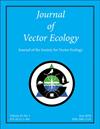Pathogen prevalence in Amblyomma americanum and Ixodes scapularis ticks from central Appalachian Virginia, U.S.A.
IF 1.3
3区 农林科学
Q2 ENTOMOLOGY
引用次数: 4
Abstract
ABSTRACT: Ticks are known vectors of several viral, bacterial, and protozoal pathogens that cause disease in both humans and animals. While pathogen prevalence has been studied extensively in other portions of the United States, pathogen surveillance studies within tick populations in the central Appalachian region of Virginia is almost nonexistent. Two prominent species in this region are Ixodes scapularis (the blacklegged tick) and Amblyomma americanum (the lone star tick). In this study, we collected ticks biweekly from three habitat types (forest, urban, and pasture) across eight counties in southwest Virginia from June, 2019–November, 2020. Ixodes scapularis and A. americanum captures were screened for evidence of associated tick-borne pathogens. In this region, Borrelia burgdorferi sensu stricto (15.3% in nymphs and 37.6% in adults), Anaplasma phagocytophilum (1.9% in nymphs and 12.2% in adults), and Borrelia miyamotoi (2.97% in nymphs and 2.33% in adults) were detected in I. scapularis ticks. Aside from two previously reported Powassan-positive I. scapularis ticks from Floyd County, VA, no additional Powassan-positive ticks are reported here. No evidence of Ehrlichia chaffeensis, Heartland virus (HRTV), or Bourbon virus (BRBV) was detected in collected A. americanum. Detection and confirmation of multiple emerging tick-borne pathogens in this region raises an increased concern for public health risk, calling for heightened awareness of tick-borne pathogen transmission and increased tick surveillance in understudied areas.来自美国弗吉尼亚州阿巴拉契亚中部的美洲硬蜱和肩胛硬蜱的病原体流行率。
摘要:蜱是已知的几种病毒、细菌和原生动物病原体的载体,这些病原体会导致人类和动物的疾病。虽然病原体流行率在美国其他地区进行了广泛研究,但在弗吉尼亚州阿巴拉契亚中部地区的蜱虫种群中几乎没有病原体监测研究。该地区的两个著名物种是肩胛硬蜱(黑腿蜱)和美洲硬蜱(孤星蜱)。在这项研究中,我们从2019年6月至2020年11月,每两周收集一次来自弗吉尼亚州西南部八个县三种栖息地类型(森林、城市和牧场)的蜱虫。对肩胛硬蜱和美洲硬蜱捕获物进行了筛选,以寻找相关蜱传病原体的证据。在该地区,在肩胛蜱中检测到狭义伯氏疏螺旋体(若虫15.3%,成虫37.6%)、吞噬细胞无浆体(若若虫1.9%,成虫12.2%)和米亚莫泰疏螺旋体,若虫2.97%,成虫2.33%)。除了之前报告的两个来自弗吉尼亚州弗洛伊德县的Powassan阳性I.肩胛骨蜱外,这里没有其他Powassan阴性蜱的报告。在采集的A.americanum中未检测到查菲埃立克体、心脏地带病毒(HRTV)或波旁病毒(BRBV)的证据。在该地区检测和确认多种新出现的蜱传病原体,引发了人们对公共卫生风险的日益担忧,呼吁提高对蜱传病原体传播的认识,并在研究不足的地区加强蜱虫监测。
本文章由计算机程序翻译,如有差异,请以英文原文为准。
求助全文
约1分钟内获得全文
求助全文
来源期刊

Journal of Vector Ecology
生物-昆虫学
CiteScore
2.60
自引率
5.90%
发文量
31
审稿时长
6-12 weeks
期刊介绍:
The Journal of Vector Ecology is an international journal published by the Society for Vector Ecology. It is concerned with all aspects of the biology, ecology, and control of arthropod and vertebrate vectors and the interrelationships between the vectors and the agents of disease that they transmit. The journal publishes original research articles and scientific notes, as well as comprehensive reviews of vector biology based on presentations at Society meetings. All papers are reviewed by at least two qualified scientists who recommend their suitability for publication. Acceptance of manuscripts is based on their scientific merit and is the final decision of the editor, but these decisions may be appealed to the editorial board. The journal began publishing in 1974 and now publishes on-line only.
 求助内容:
求助内容: 应助结果提醒方式:
应助结果提醒方式:


